![]() Add To Cart This Word Template
Add To Cart This Word Template
 Add To Cart Proposal Pack Aerospace #4
Add To Cart Proposal Pack Aerospace #4
 Add To Cart Proposal Kit Professional Bundle
Add To Cart Proposal Kit Professional Bundle


Key Takeaways
- One-time License, No Subscriptions: Pay once and use Proposal Kit forever with an up-front price lower than monthly services over time.
- Best Template Flexibility: Start with a proven Educational Grant Sample Proposal #2 and customize every section, logo, and color to fit your brand and project scope.
- Instant Access: Download immediately and open the sample proposal right away with no waiting, no onboarding delay.
- Ready-Made Structure: See a complete, real-world example (executive summary, scope, schedule, budget, and more) you can mirror for your project. Get a Proposal Pack or Professional package and use the AI Writer to create custom tailored samples or complete first drafts.
- Fully Editable Documents: Replace text, sections, and branding in minutes - no special software skills required.
- Step-by-Step Help: The Proposal Pack Wizard training mode, documentation, and videos guide you through customizing every section so you do not get stuck.
- Built-In Pricing and Quotes: Automate line-item quotes, totals, and taxes from a database, and insert tables/charts so your pricing is clear and consistent.
- Clear Pricing and Bundles: Choose a single industry pack or the Professional bundle for straightforward options that keep costs predictable as your needs grow.
How to write your Educational Grant Proposal #2
You can create your customized editable variation of this document using Proposal Kit. Follow these steps to get started.
 DOWNLOADABLE, ONE-TIME COST, NO SUBSCRIPTION FEES
DOWNLOADABLE, ONE-TIME COST, NO SUBSCRIPTION FEES
Proposal Pack includes everything you need to get started now
- This sample proposal plus
- Library of all 200 samples
- Library of editable templates
- All templates in this design
- Basic contracts and invoices
- Financial calculators
- Wizard proposal software
- How to Write a Proposal e-books
- Customize with your logo
Screenshots of 4 of 19 pages of this sample
Click the PDF View link above to see more. The complete sample is included in every Proposal Pack and the included Wizard software can build you an editable version in Word that will be in the design theme you purchased. You can purchase a different design theme than the sample is illustrated with.
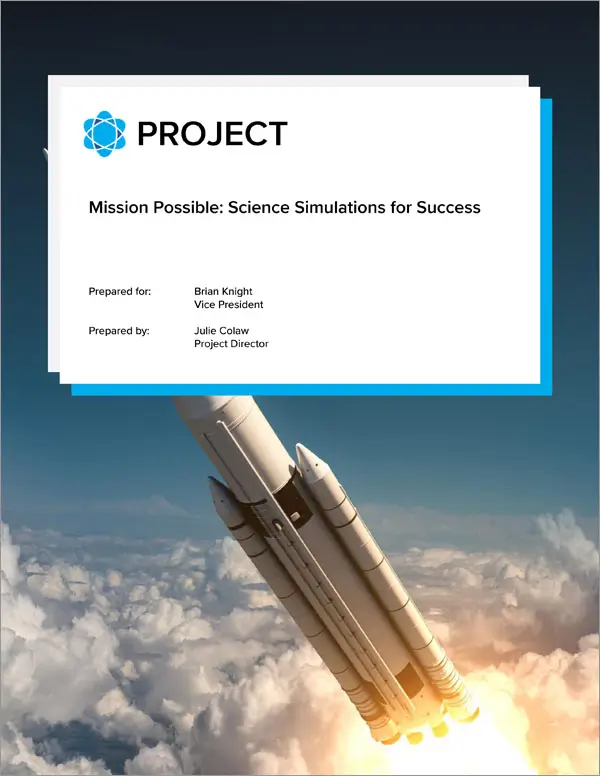
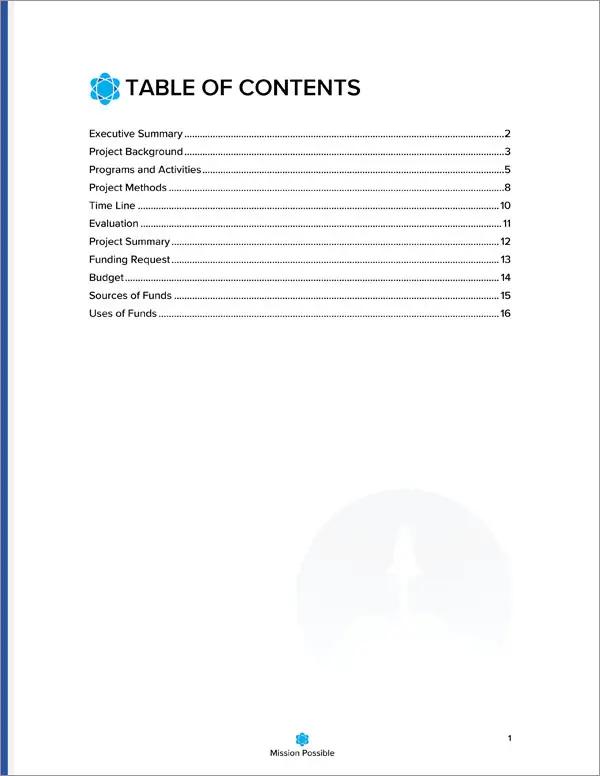
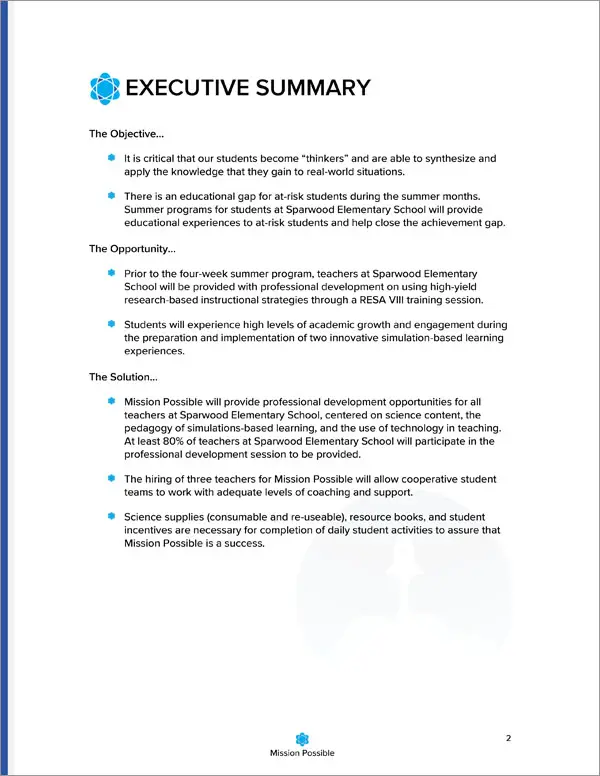
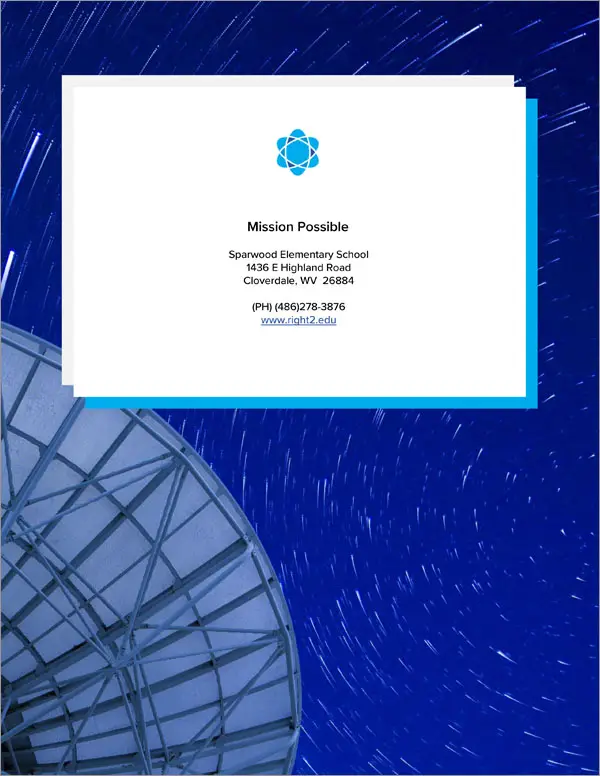
1. Get a Proposal Pack such as Aerospace #4
This sample was created using the design theme Proposal Pack Aerospace #4. You can recreate this same sample using any of our Proposal Pack design themes and have it customized for your business.
We include this sample in PDF and editable Word format chapters that can be customized using the included Wizard software when purchased with a Proposal Pack or the Professional Bundle.
To create your customized proposal using your logo and colors, get Proposal Pack for Any Business. We include this sample in every Proposal Pack.
2. Download and install after ordering
Once you have ordered and downloaded your Proposal Pack you will have all the content you need to get started. If you order the sample as a template you will download the Word document after ordering and edit it in your office software.
3. Set up the included Wizard software
While the Wizard software makes the process more efficient, you can manually assemble your version of this sample using the content provided and just a Word processor. We only include the Wizard software with a Proposal Pack or the Professional Bundle.
4. Import the Quick Start layout titled 'Educational Grant Sample Proposal #2'
The included Proposal Pack Wizard software makes creating a customized version of this document speedy and efficient. The sample content is in Word format documents, so you can also use the sample text without using our Wizard software. Using the Wizard software, you can create custom variations of this template and automate your quotes with the line item database.
The Mission Possible Grant Sample Proposal is an example of a grant proposal created using Proposal Pack. This example shows how our Proposal Packs can be used for virtually any type of proposal. In this example a public school is requesting funding for a student project.
Teachers and schools seeking grant funding for student projects.
5. Customize the template with your information
You can customize the layout with different chapters, change the order of chapters, import your content and information, change the visual design, edit the text, and more. You have complete control over customizing this sample. Use the Wizard's AI Writer to create personalized content specific to your business and project that can be merged with the sample.
Once finished, the AI Writer's Word-to-PowerPoint converter can transform your proposal, business plan, or other business documents into a PowerPoint slideshow.
Abstract
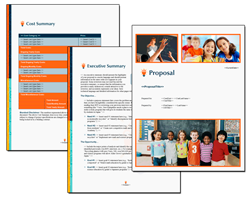
This sample educational grant proposal demonstrates how schools in the social sciences can seek additional funding to support innovative learning initiatives. Presented as a formal request, the proposal outlines the critical need for resources to assist at-risk students, particularly during the summer months when the majority risk falling further behind academically. Through the inclusion of a cover letter and a detailed budget, the proposal explains how the requested funds will pay for important personnel, teacher training, and educational supplies.
By investing in problem-based learning simulations and professional development, the program aims to enhance both student achievement and staff capabilities. The proposal's structure highlights the importance of targeted support in rural, low-income communities, showing how additional funding can bridge achievement gaps and foster long-term educational success.
Presented as an approach to securing additional funding, this educational grant sample proposal addresses the specific challenges faced where a majority of students are economically disadvantaged and at increased risk of academic decline. The proposal highlights how targeted support for personnel - such as specialized teachers and facilitators - can assist students in developing critical thinking and real-world problem-solving skills within the social sciences. The inclusion of a detailed cover letter and a robust narrative ensures that the proposal clearly communicates the value of the program to potential funders.
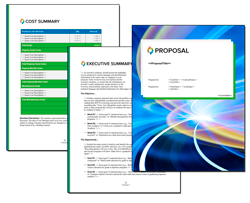
Using Proposal Kit's advanced features, schools and organizations can efficiently assemble and customize their own grant proposals, saving time while ensuring all required topics are presented in a professional format. This approach helps educators and administrators to focus more on the needs of their students and less on the complexities of documentation. By streamlining the process, Proposal Kit assists applicants in making a stronger case for why they should receive additional funding to pay for much-needed resources - including both staff and educational materials. Ultimately, well-written proposals like this one improve opportunities for students in underserved areas, helping to close learning gaps and support long-term academic achievement.
Beyond its immediate purpose, this sample proposal underscores broader issues that affect many educational institutions, especially in rural and low-income regions. The document emphasizes the necessity of additional funding not only for supplies but also to strengthen the social sciences curriculum and professional development for personnel. By integrating research-based instructional methods and immersive simulation experiences, the program is designed to boost students' confidence and engagement, which in turn supports higher academic performance and a greater likelihood of future success. The use of a cover letter and thorough project narrative in the proposal helps articulate these goals to potential funders, making the case for sustained investment in both student and teacher growth.
Furthermore, the widespread adoption of the structured proposal Proposal Kit democratizes access to high-quality grant writing, allowing a majority of schools and organizations - regardless of their internal resources - to present compelling requests for support. This assists smaller or less experienced teams in paying closer attention to the details funders expect, ultimately raising the standard of educational grant submissions across the sector. As a result, more students may benefit from innovative programs, and the positive impact can ripple outward to families and communities by elevating educational outcomes and narrowing persistent achievement gaps.
Educational Grant Sample Proposal #2 - The Narrative
Sparwood Elementary School requires funding of $9 300.00 for teacher training supplies and services for our Mission Possible project which will provide computer based simulations or missions to up to students for the coming school year. Mission Possible is four week program that will meet four hours each day four days week. Thirty students selected to participate based on academic need will complete classroom preparatory activities and participate in problem based learning simulations in coordination with the Challenger Learning Center at Wheeling Jesuit University.
The Objective
It is critical that our students become "thinkers" and are able to synthesize and apply the knowledge that they gain to real world situations. There is an educational gap for at risk students during the summer months. Summer programs for students at Sparwood Elementary School will provide educational experiences to at risk students and help close the achievement gap.
The Opportunity
Prior to the four week summer program teachers at Sparwood Elementary School will be provided with professional development on using high yield research based instructional strategies through RESA VIII training session. Students will experience high levels of academic growth and engagement during the preparation and implementation of two innovative simulation based learning experiences.
The Solution
Mission Possible will provide professional development opportunities for all teachers at Sparwood Elementary School centered on science content the pedagogy of simulations based learning and the use of technology in teaching. At least 80% of teachers at Sparwood Elementary School will participate in the professional development session to be provided. The hiring of three teachers for Mission Possible will allow cooperative student teams to work with adequate levels of coaching and support.
Science supplies consumable and re useable resource books and student incentives are necessary for completion of daily student activities to assure that Mission Possible is success. Sparwood Elementary School is K facility with students. Located in Grant County in the scenic Potomac Highlands Sparwood Elementary is the heart of our rural community. The poultry farming and timber industries are the primary sources of income.
Fifty six percent of Sparwood Elementary Students receive free or reduced meals. The unemployment rate in Grant County is 8.6% which is an increase of 8% from ten years ago. Twenty one percent of Grant County children live in poverty. The average family income in Grant County is $27 743.
Almost 20% of Grant County adults scored at Level the lowest level of literacy skills. These adults typically have difficulty performing everyday tasks such as locating an intersection on street map reading and comprehending newspaper article or calculating total costs on an order form. Therefore it is not surprising that these parents and possibly others may be unable to provide their children with the support needed to help them reach their academic potential.
This is particularly problematic for students who fall behind their grade level peers. Research indicates that children living in rural and low income communities often fall behind academically during the summer months. Summer programs for students at Sparwood Elementary School will provide educational experiences to at risk students and help close the achievement gap. Sparwood Elementary School’s most recent Stanford Achievement Test SAT results showed that Special Education students learning at Sparwood Elementary did not meet Adequate Yearly Progress AYP according to the No Child Left Behind NCLB legislation.
Results from the following year WESTEST also showed lack of adequate yearly gains by the Special Education subgroup of students. Consequently Sparwood Elementary School has been placed on School Choice and is designated as Title Improvement School. Staff members at Sparwood Elementary School are committed to assuring success for all students.
Goal in Sparwood Elementary School’s Unified School Improvement Plan states "The students at Sparwood Elementary School will meet AYP as established by the West Virginia Department of Education." Our first improvement objective is "PES staff will analyze test data to determine grade level strengths and weaknesses. Teachers will develop and initiate re teaching strategies to provide intensive instruction to students in the lowest quartile." Analysis of last year’s science test scores has been completed and partial comparison of scores is shown below. WESTEST previous year results from Sparwood Elementary show higher percentages of economically disadvantaged students and students with disabilities in each grade level not reaching levels of proficiency compared to the "All Students" cell.
Further analysis of test scores showed specific areas in which there are problematic trends across grade levels and subgroups. These areas are. Interpreting data drawing conclusions from data inferring using evidence using reason in making decisions drawing conclusions reasoning conclusions impacts of technology and identifying tasks to complete.
The ability to interpret data showed the greatest number of questions on which scoring was below the 60th percentile. This is true for grades and and may indicate curricular or instructional strategies weaknesses. The abilities to reason draw conclusions infer solve problems and apply science concepts all require higher levels of thinking in Bloom’s Taxonomy. It is critical that our students become "thinkers" and are able to synthesize and apply the knowledge that they gain to real world situations.
This will require change in the way instruction is delivered from "teacher directed" to student centered classrooms. The use of high yield research based instructional strategies must be utilized to increase student achievement. Therefore it is imperative that staff development focusing on effective research based instructional strategies is part of the plan for increasing student achievement for all students.
Mission Possible will provide professional development opportunities for all teachers at Sparwood Elementary School centered on science content the pedagogy of simulations based learning and the use of technology in teaching. The primary task of Mission Possible will be to address specific science content areas through participation in hands on student centered instruction. At risk students will be given priority in the selection process. Mission Possible staff will teach student participants learning strategies that will help them understand science content and apply that knowledge in real life situations.
This instruction will be delivered in coordination with the Challenger Learning Center at Wheeling Jesuit University and Eastern West Virginia Technical College. The following outlines our projected programs and activities. Prior to the four week summer program teachers at Sparwood Elementary School will be provided with professional development on using high yield research based instructional strategies through RESA VIII training session.
At least 80% of teachers at Sparwood Elementary School will participate in the professional development session to be provided.
Research Based Professional Development
The first phase of Mission Possible will be professional development program provided through RESA VIII staff at Sparwood Elementary School. The focus of the session will be the use of research based instructional strategies through Problem Based Learning PBL scenarios. Particular focus of this training will be on the strategies of cooperative learning setting objectives and providing feedback and using cues questions and advanced organizers.
All of these are strategies that will be utilized for student instruction throughout the Mission Possible summer program. A study of the use of cooperative learning Johnson Johnson Nelson & Skon shows that cooperative learning when compared with strategies in which students individually compete with others has an effect size of.78. This same study also shows a.78 effect when compared with strategies in which students work individually on tasks without competing with each other. Setting objectives is the process of determining the course for learning.
It is skill that successful people have mastered to help them realize both short term and long term desires Marzano Pickering and Pollock. Specific strategies for teaching students to set specific but flexible goals or to set contracts for the attainment of goals will be addressed in this staff development session. After analyzing almost 1000 studies researcher John Hattie had this to say about the importance of providing feedback. "The most powerful single modification that enhances achievement is feedback.
The simplest prescription for improving education must be dollops of feedback." Teacher participants will be trained to provide corrective timely and criterion specific feedback. Teachers will also learn strategies to help students provide some of their own feedback. Cues and questions are ways that teacher helps students utilize knowledge that they already have about topic.
Research in classroom behavior indicates that cueing and questioning might account for as much as percent of what occurs in given classroom on given day Davis O.L. & Tinsley 1967; Fillipone Available research provides generalizations that can guide teachers in effective use of cues questioning and advanced organizers. RESA VIII staff will provide training in ways to maximize student benefits from all of these strategies.
Future professional development sessions related to research based instructional strategies will be provided following analysis of this session’s evaluation forms. Students will experience high levels of academic growth and engagement during the preparation and implementation of two innovative simulation based learning experiences.
Objectives
Participants will show 20% increase in ability to interpret data 20% increase in ability to draw conclusions from data and 20% increase in ability to infer using evidence. Participants will also show 20% increase in ability to use reasoning in making decisions 20% increase in their ability to understand impacts of technology and 20% increase in their ability to identify tasks to complete.
Student Simulation Based Learning Experiences
The first simulation Operation Montserrat is all about Earth’s fragile systems and the interplay between life land air and water. This simulation encourages students to take on the role of scientists by gathering analyzing and interpreting data to solve real life problems. At the end of the mission the flight director conducts post mission briefing and reviews the event giving the young scientists the opportunity to evaluate what they have learned. Throughout this mission students will.
Use tools and techniques to analyze and interpret data. Create descriptions formulate explanations and make predictions using evidence. Think critically and logically to determine relationships between evidence and explanations. Conduct systematic risk analysis.
Identify the type of hazard analyze the risks and predict the human consequences. Graph incoming data using coordinates or latitude longitude. Make estimates and predictions based on the data. Apply and adapt variety of appropriate strategies to solve problems.
Communicate scientific thinking to peers teachers and others. Gain relevant knowledge of Earth systems and the interplay between life land air and water. The scenario used in the second simulation Moon Mars and Beyond takes place in the year 2080. Mission controllers on Mars Mission Possible Students monitor routine launch from our moon to Mars.
Soon after the launch Earth Mission Control blasts through with an urgent message. An exploration vessel has not communicated in five days. It is feared that the ship and its crew are lost somewhere in the far reaches of the solar system.
Mission Control requests the help of student scientists in this rescue mission. The Mars Mission Controllers Mission Possible Students join one of five emergency teams and become one of three specialists. Rescue navigation or cargo.
The teams work together to find and rescue the lost explorers. Throughout this mission students will. Interpret data that tells where the ship has been spotted over the last five days.
Use critical thinking skills to track the course of the lost ship and predict its current location. Use graphing skills to plot the location of each planet on an – coordinate plane locate and plot any unknown objects and create map of the ship’s route. Use math skills to figure out how much food water and oxygen is required for the rescue with two astronauts making the trip out and four coming back. Become familiar with earth systems science.
Become familiar with the solar system and nine planets. Design way to demonstrate scale. Apply prior knowledge of daily life in space make inferences of similar concepts and draw conclusions.
Write persuasive piece in the form of an application with clearly stated position or opinion and supporting detail. Identify specific locations on map. Use map symbols. Read to locate and interpret information from written text.
Use context clues within letters and mails. Recall information to interpret clues. In order to effectively implement the Mission Possible summer program staff for this program must understand how inquiry and problem based models of instruction work.
Staff development will occur prior to implementation of Mission Possible and will be required for Mission Possible Staff. Mission Possible teachers must complete training from the RESA VIII as well as staff development activities from the Challenger Learning Center specific to implementation of Operation Montserrat and Moon Mars and Beyond. These trainings will ensure that Mission Possible staff members are able to guide students through pre flight and simulation activities with the maximum educational benefits using research based strategies for increasing student achievement. The research based strategies stated below will be the focus of staff development.
Mission Possible teachers will utilize these strategies and others to assure student success in all aspects of this program. A study of the use of cooperative learning Johnson Johnson Nelson & Skon shows cooperative learning when compared with strategies in which students individually compete with others has an effect size of.78. This same study also shows a.78 effect when compared with strategies in which students work individually on tasks without competing with each other. Throughout the entire Mission Possible program students will be immersed in activities with their cooperative learning teams.
Setting objectives is the process of determining the course for learning. It is skill that successful people have mastered to help them realize both short term and long term desires Marzano Pickering and Pollock. Strategies for teaching students to set specific but flexible goals or to set contracts for the attainment of goals will be addressed in staff development session.
Students will learn to set personal and team learning goals as an integral part of the Mission Possible curriculum. They will also learn how to evaluate these goals. After analyzing almost 1000 studies researcher John Hattie had this to say about the importance of providing feedback.
"The most powerful single modification that enhances achievement is feedback. The simplest prescription for improving education must be dollops of feedback." Teachers will be trained to provide corrective timely and criterion specific feedback. They will also learn strategies to help students provide some of their own feedback.
Again this professional development session is required for Mission Possible staff. Mission Possible and Challenger Learning Center staff will provide ongoing feedback to Mission Possible students during pre flight and simulation activities to assure successful learning experience. Cues and questions are ways that teacher helps students utilize knowledge that they already have about topic. Research in classroom behavior indicates that cueing and questioning might account for as much as percent of what occurs in given classroom on given day Davis O.L.
& Tinsley 1967; Fillipone Keeping this in mind it is imperative that teachers maximize the benefits of cueing and questioning to encourage students to think and perform at higher levels. Mission Possible is based upon classroom environment where students work cooperatively in teams to identify research and solve problems; gather and interpret data and apply their experiences to real world situations.
The teachers in Mission Possible activities will be cognitive coaches rather than "imparters of knowledge."
The use of technology is large part of Mission Possible activities. Students will learn to use tools and techniques in the classroom and on the Internet to analyze and interpret data. Students will participate in online research and gather pertinent information to help them make and defend decisions in Mission Day activities. The National Association for the Education of Young Children NAEYC recognizes the impact that computer technology is having on the world.
The NAEYC states that the use of technology should be integrated into the regular learning environment and used as one of the many options to support children’s learning.
Strategies in Review
RESA VIII staff development focused on inquiry and problem based cooperative learning setting objectives providing feedback and effective use of cueing and questioning. All Sparwood Elementary and Mission Possible Staff. Challenger Learning Center professional development specific to implementation of Operation Montserrat and Moon Mars and Beyond. Mission Possible Staff plus available space for other Sparwood Elementary teachers.
Follow up staff development session Fall. Teachers will share how they were able to utilize information from this session. Further professional development needs in this area will be discussed.
Mission Possible will utilize problem based learning simulations in which the student assumes the role of an active problem solver and decision maker. Students will explore science content with teachers guiding this educational experience using high yield research based instructional strategies. Using inquiry and investigation the students will develop possible solutions to relevant problems. The use of technology is large part of Mission Possible activities.
Students will learn to use tools and techniques in the classroom and on the Internet to analyze and interpret data. Students will participate in online research and gather pertinent information to help them make and defend decisions in Mission Day activities. Mission Possible will provide students an opportunity to experience high levels of academic growth and engagement during the preparation and implementation of two innovative simulation based learning experiences.
Each simulation will involve nearly two weeks of pre mission planning and research with culminating activities that are interactive live broadcasts with flight directors at Challenger Learning Center’s Mission Control. Throughout the Mission Possible program students are immersed in activities with their cooperative learning teams. Key project dates for the coming year are outlined below.
Dates are "best guess" estimates and are subject to change before being locked in by binding contract. March - RESA VIII staff development. April - Announcement of Mission Possible Summer Program through news release in the Grant County Press. May - Applications for enrollment in Mission Possible will be distributed.
May - Applications will be scored and applicants will be notified of their acceptance into Mission Possible. June 7 - Day One of Mission Possible Summer Program. Operation Montserrat Day 1. June 17 - Operation Montserrat Simulation Mission Day.
June 20 - Day One of Moon Mars and Beyond activities. June 30 - Moon Mars and Beyond Mission Day and culminating parent activities. July 1 - Teacher evaluation of program objectives analysis of test data and review and compilation of parent and student survey results. In order to track the effectiveness of the project and to judge the outcome the following evaluation plan will be used.
Science Content
A pre test on identified skills will be given to all participants on the first day of Mission Possible. At the completion of the four weeks of summer school the students will be given post test. The results will be compared to determine the percentage of growth made by each student.
Pre test and post test content will include interpreting data drawing conclusions from data inferring using evidence using reason in making decisions drawing conclusions reasoning conclusions impacts of technology and identifying tasks to complete. Students will self evaluate their work each day through the use of journals. Mission Possible staff will provide written feedback each day in these journals to guide student learning and recognize effort.
Student Survey
All students will complete an interest satisfaction survey at the completion of Mission Possible. The survey will address student feelings about activities and strategies used to promote science skills. The survey will be used to direct the program of study for future summer programs and for implementation of similar activities and strategies for regular classroom use for the coming school year. Results may also be an indicator for areas of need for professional development.
Parent Survey
All parents caregivers will complete an interest satisfaction survey at the completion of Mission Possible. The survey will address how the parents caregivers felt about the program in relation to how well their children progressed. The survey will be used to direct future parental involvement activities and to help us better meet the needs of parents.
Teacher Survey
All teachers involved in Mission Possible will complete an informational survey. The results of this survey will serve as partial needs assessment for future summer programs. The information will also be used to help determine the strengths and weaknesses of Mission Possible.
Approximate number of students to be served. 24-30 Students. Grade level of students. Students entering grades 6 for the coming school year. Number of professional staff, three.
Percent of students in school on free or reduced lunch 56%. In summary the goals of Mission Possible are to. Provide staff training on effective uses of research based strategies to all Sparwood Elementary School teachers by RESA VIII staff. Encourage continued professional development through teacher participation in InStep and InStep Online.
Provide content specific instruction to student participants in the areas of. Interpreting data drawing conclusions from data inferring using evidence using reason in making decisions drawing conclusions reasoning conclusions impacts of technology and identifying tasks to complete last year’s WESTEST low scoring areas. Provide at risk students priority in the Mission Possible selection process. Utilize research based strategies throughout Mission Possible learning experiences.
The following summarizes Mission Possible’s request for funding. Funding is to be used for the upcoming summer. Following is list of all sources of funds and in kind support for the proposed project.
The Grant County Board of Education will serve as the fiscal agent for Mission Possible. They will provide full use of air conditioned facilities telephone and copier services electricity and computer labs with Internet connectivity. Sparwood Elementary School will provide up to $500.00 for science equipment to support Mission Possible activities. Eastern West Virginia Community College will provide free of charge the use of Portable Distance Learning Equipment and 4 hours of connectivity with Challenger Learning Center in Wheeling West Virginia.
An on site technical support person for two days during the mission simulations will also be provided for small fee. RESA VIII staff will provide professional development for Sparwood Elementary School and Mission Possible staff on problem based learning and inquiry instructional strategies. This session will be offered free of charge. The Challenger Learning Center at Wheeling Jesuit University will provide professional development related to the implementation of two Missions Operation Montserrat and Moon Mars and Beyond.
Challenger staff will review students’ proposals provide feedback and schedule mission time. Challenger’s Flight Director will conduct post mission briefing and give Mission Possible participants the opportunity to evaluate what they have learned. Eastern Allegheny Council for Human Services will provide breakfast and lunch on site and free of charge to Mission Possible participants through the Summer Foods Program. Grant County Health Department will provide food handler’s training for the teachers and parent volunteers who help with meal and snack preparation.
The WVU Extension Service H program will provide Teen Leaders who will serve as volunteer mentors for Mission Possible. The Grant County Press will provide public recognition for Mission Possible activities and the participants’ educational successes. Mission Possible requires funding for the completion of the project. Funds are to be used as follows.
Mission Possible is centered around two Mission simulations provided in cooperation with Challenger Learning Center at Wheeling Jesuit University. The funds allocated for the Missions are necessary to provide real world simulations through distance learning technologies. It is during these missions that skills students learn in the days leading up to the simulations are put to the test to "save" the residents of the tropical island of Montserrat from hurricane and volcanic eruption.
Two weeks later students will then safely find and rescue lost space explorers in Mission Moon Mars and Beyond. The use of the Distance Learning Equipment is provided free of charge by Eastern West Virginia Technical College EWVTC with the exception of the technical support component. The small fee for the technical support provided by EWVTC is necessary to assure that all distance learning equipment is operating correctly throughout the actual Missions. The funds allocated for science supplies consumable and re useable resource books and student incentives are necessary for completion of daily student activities to assure that Mission Possible is success.
Lab coat for each participant will be purchased for use during Mission Possible to help provide authentic simulations. These lab coats will be saved for use in the Sparwood Elementary Science Lab for future Mission simulations and activities. Colored pencils regular pencils rulers Post it Notes overhead projection markers task boards and transparencies are necessary for the Cargo Navigation and Rescue Teams for the Moon Mars and Beyond Mission. Graph paper journals calculators and card stock will also used during classroom preparatory activities.
Operation Montserrat Hurricane Volcano Evacuation and Communication Teams will need access to digital camera printer and ink cartridges for the printer. Markers compasses pens paper pencils and journals will also be necessary. Supplies for making room decorations mission patches and posters for the walls will help authenticate the role of each team throughout the simulations.
The hiring of three teachers for Mission Possible will allow cooperative student teams to work with adequate levels of coaching and support. Teachers will be able to provide immediate and meaningful feedback to cooperative groups of or less students. Student learning will be supported with teaming cueing and immediate and meaningful feedback by highly trained and motivated Mission Possible staff.
Mission Possible is four week program that will meet four hours each day four days week. Thirty students selected to participate based on academic need will complete classroom preparatory activities and participate in problem based learning simulations in coordination with the Challenger Learning Center at Wheeling Jesuit University. Sparwood Elementary School is public school and is tax exempt.
 What Our Clients Say
What Our Clients SayThe more we use the "kits" the better we feel about the end results and the "kits" we feel are responsible for our increasing successes. Thanks for the templates and we look forward to a long life with their "assistance"."
Managing Partner
The Cross Group LLC
There are 200 complete sample proposals including this one in each Proposal Pack
The following related samples are also included in Proposal Pack:
These template layouts are related to this sample
The following related templates are also included in Proposal Pack with this sample:
- Educational Grant Proposal
- Daycare Preschool Grant Funding Proposal
- DOE Federal Government Grant Proposal
- STEM Educational Program Proposal
- Vocational Education Proposal
- New College Curriculum Proposal
- Charter School Educational Proposal
- Specialized Training Educational Proposal
- Tutoring Educational Services Proposal
- Educational Grant Proposal
- School Improvement Project Proposal
- Computer Lab for Students Educational Proposal
- DOE Federal Government Grant Proposal #2
- Educational Training for Special Needs Proposal
- Science Lab for Students Educational Proposal
Length of Sample
19 PagesThere are thousands of chapters to choose from in Proposal Pack. This sample uses the following set of Proposal Pack chapter templates: Cover Sheet, Title Page, Table of Contents, Executive Summary, Project Methods, Project Background, Time Line, Evaluation, Sources of Funds, Uses of Funds, Funding Request, Budget, Project Summary, Programs and Activities, Back Page.
Educational Grant Sample Proposal #2 Calculator Spreadheets
These Excel calculator spreadsheets are included with this template. If you purchase a Proposal Pack or the Professional Bundle, these proposal pages are generated using an automated line-item database in the included Wizard software. The calculator spreadsheets are intended for use when purchasing only the sample as a static Word template.
Time Line Calculator, Funding Request Calculator, Budget Three Year Calculator
This sample illustrates how to write the following types of proposals
- General business proposal
- Education, training proposal
- Non-technical proposal
- Project pitch proposal
- Non-government grant, non-profit, NGO proposal
- Student project proposal
- Many other types of proposals
Samples can be created in any Proposal Pack design theme
This sample was created with Proposal Pack Aerospace #4. To change the visual look purchase any Proposal Pack and this sample will be created in that design theme.
Out of the over 501 Proposal Packs available these designs are also popular for this type of proposal and this sample proposal is also included in every Proposal Pack:
Photo Design Proposal Packs
 Proposal Pack Education #3
Proposal Pack Education #3 Proposal Pack In Motion #7
Proposal Pack In Motion #7 Proposal Pack Telecom #4
Proposal Pack Telecom #4Line Art Design Proposal Packs
 Proposal Pack Business #16
Proposal Pack Business #16 Proposal Pack Classic #11
Proposal Pack Classic #11 Proposal Pack Concepts #8
Proposal Pack Concepts #8 Proposal Pack Contemporary #3
Proposal Pack Contemporary #3 Proposal Pack Contemporary #4
Proposal Pack Contemporary #4 Proposal Pack Contemporary #6
Proposal Pack Contemporary #6 Proposal Pack Education #1
Proposal Pack Education #1 Proposal Pack Education #2
Proposal Pack Education #2 Proposal Pack Science #1
Proposal Pack Science #120% Off Discount
![]() Add To Cart This Word Template
Add To Cart This Word Template
 Add To Cart Proposal Pack Aerospace #4
Add To Cart Proposal Pack Aerospace #4
 Add To Cart Proposal Kit Professional Bundle
Add To Cart Proposal Kit Professional Bundle
 4.7 stars, based on 849 reviews
4.7 stars, based on 849 reviewsHow to Write a Grant Proposal
This video shows how to use Proposal Kit to create a document to respond to any grant funding application or RFP including to private organizations and government agencies. Using Proposal Kit you can select a design theme, select a set of chapters to match your RFP or grant submission guidelines, generate a document, fill in with your content then deliver as needed.
Frequently Asked Questions
How do I customize this sample to fit my specific project or business?
If you purchase this sample as a static template, it will be an editable Word format document; otherwise, if you buy a Proposal Pack or the Professional bundle, you can build a more customized editable Word document version of it using the included Wizard software. You can replace the sample information with your own, adjust the text to match your company's tone and style, and modify sections to include project-specific details. The included AI Writer will also customize the content for you.
Can I use multiple sample proposals for different types of projects?
You can purchase multiple samples as individual Word templates or all 200 samples are included in every Proposal Pack and Proposal Kit Professional, which is a much better deal. The Proposal Kit offers sample proposals for various industries and project types. You can select and customize different sample proposals to suit each unique project. This flexibility allows you to create tailored proposals for other clients or projects.
How can I integrate my branding into this sample?
While this sample is an editable Word document, depending on the level of custom branding needed, consider the Proposal Kit Professional, which includes the branding features in the Wizard software that let you create custom-branded design themes more effectively. Start by incorporating your company's logo on the cover page, as well as in the headers and footers of the document. Next, adjust the color scheme of the proposal to match your brand colors. Change the fonts in the proposal to align with your brand's standard fonts. Including branded graphics that reflect your brand's style will further enhance the proposal. Additionally, ensure that the text within the proposal maintains a tone and voice consistent with your brand's communication style. By integrating these elements, your proposal will reinforce your brand identity.
How do I ensure my proposal stands out and wins the client?
To ensure your proposal stands out:
- Personalize the content: Address the client's needs, challenges, and goals to make the proposal unique.
- Highlight your value proposition: Communicate what sets your business apart and how to deliver superior results.
- Use professional design elements: Incorporate visuals, charts, and graphs to enhance the presentation and make it more engaging.
- Proofread and edit: Ensure the proposal is error-free and well-organized. A polished, professional document reflects your attention to detail and professionalism.
What should I do if I need help understanding or modifying a section of this sample?
If you need help understanding or modifying a section of this sample, refer to the detailed instructions provided. Additionally, Proposal Kit includes customer support and resources such as tutorials and videos to assist you. Consulting with a colleague or a professional in your industry can also be beneficial if further clarification is needed. Asking an AI tool can also provide valuable insights for immediate needs. You can load this sample into the Wizard software and let its AI Writer customize the pages for you.
 Ian Lauder has been helping businesses write their proposals and contracts for two decades. Ian is the owner and founder of Proposal Kit, one of the original sources of business proposal and contract software products started in 1997.
Ian Lauder has been helping businesses write their proposals and contracts for two decades. Ian is the owner and founder of Proposal Kit, one of the original sources of business proposal and contract software products started in 1997.By Ian Lauder
 Published by Proposal Kit, Inc.
Published by Proposal Kit, Inc.


 Cart
Cart
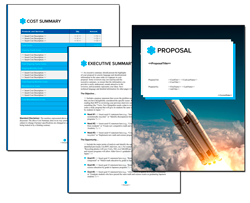

 Facebook
Facebook YouTube
YouTube Bluesky
Bluesky Search Site
Search Site